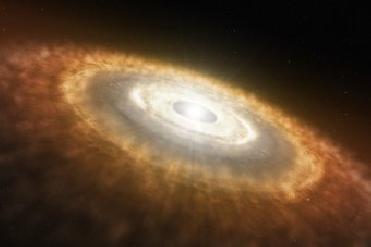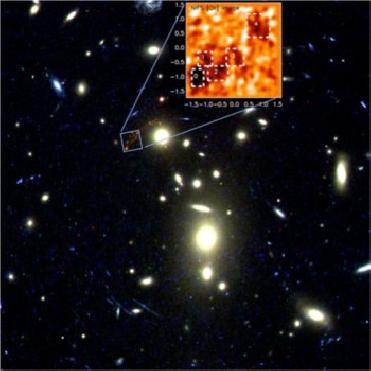
An artist's impression of a baby star still surrounded by a protoplanetary disc in which planets are forming. Using ESO's HARPS spectrograph, a team of astronomers has found that Sun-like stars which host planets have destroyed their lithium much more efficiently than planet-free stars. It is not clear what causes the lithium to be destroyed. The general idea is that the planets or the presence of the protoplanetary disc disturb the interior of a star, bringing the lithium deeper down into the star than usual, into regions where the temperature is so hot that it is destroyed. Image credit: ESO
PARIS (BNS): What distinguishes stars hosting planets, like our Sun, from their ‘barren’ cousins with no planetary systems? The anomalous presence of lithium, say astronomers.
Researchers have long puzzled in the ‘lithium mystery’ observed in our Sun – low presence of the chemical lithium in the Sun as compared to other solar-like stars.
Now, after tracking as many as 500 stars, 70 of which are known to host planets, the astronomers have derived at the conclusion that stars hosting planets “destroy their lithium much more efficiently” than ‘planet-free’ stars.
Their finding not only sheds light on the lack of lithium in our star (Sun), but also provides astronomers with a very efficient way of finding stars with planetary systems.
Using European Southern Observatory’s (ESO) High Accuracy Radial Velocity Planet Searcher (HARPS) spectrograph, the astronomers’ team monitored and analysed 500 stars, including 70 planet-hosting stars.
“For almost 10 years we have tried to find out what distinguishes stars with planetary systems from their barren cousins. We have now found that the amount of lithium in Sun-like stars depends on whether or not they have planets,” said Garik Israelian, lead author of a paper appearing in the latest issue of journal Nature.
The astronomers looked in particular at Sun-like stars, almost a quarter of the whole sample of 500 stars. They found that the majority of stars hosting planets possess less than 1% of the amount of lithium shown by most of the other ‘planet-less’ stars.
“Like our Sun, these stars have been very efficient at destroying the lithium they inherited at birth,” said team member Nuno Santos. “Using our unique, large sample, we can also prove that the reason for this lithium reduction is not related to any other property of the star, such as its age.”
Unlike most other elements lighter than iron, the light nuclei of lithium, beryllium and boron are not produced in significant amounts in stars. Instead, it is thought that lithium, composed of just three protons and four neutrons, was mainly produced just after the Big Bang, 13.7 billion years ago. Most stars will thus have the same amount of lithium, unless this element has been destroyed inside the star.
This result also provides the astronomers with a new, cost-effective way to search for planetary systems: by checking the amount of lithium present in a star, astronomers can decide which stars are worthy of further significant observing efforts.
 Previous Article
Previous Article Next Article
Next Article












The Indian Air Force, in its flight trials evaluation report submitted before the Defence Ministry l..
view articleAn insight into the Medium Multi-Role Combat Aircraft competition...
view articleSky enthusiasts can now spot the International Space Station (ISS) commanded by Indian-American astr..
view article